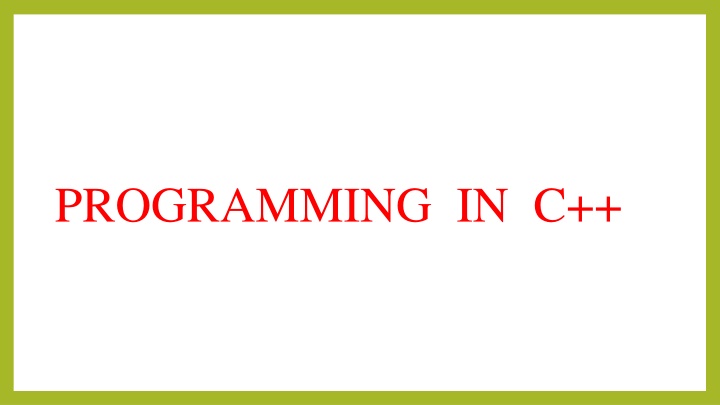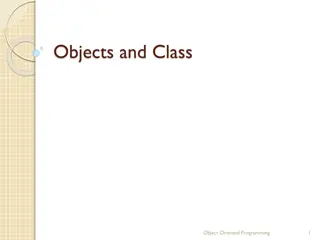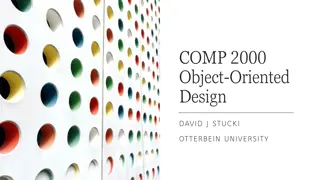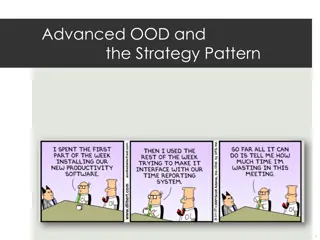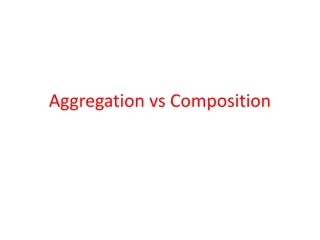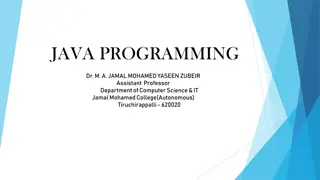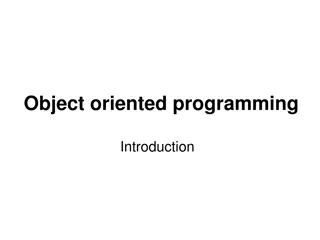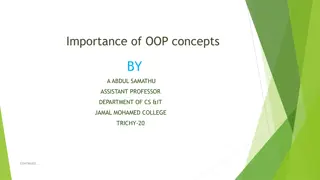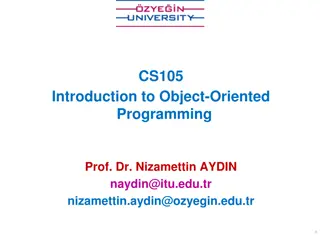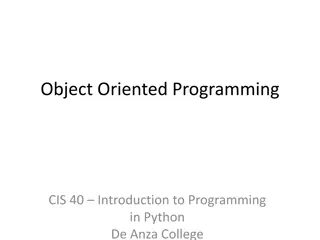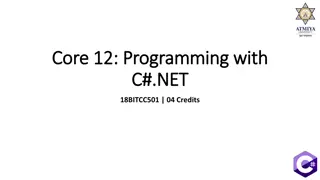Object-Oriented Programming in C++
Object-oriented programming in C++ involves the principles of objects, classes, data abstraction, encapsulation, inheritance, polymorphism, and dynamic binding. Objects represent entities in a system, classes define data and code structures, while abstraction and encapsulation provide essential information and hide details from the outside. Inheritance facilitates code reusability, polymorphism allows different uses of operators/functions, and dynamic binding links procedure calls effectively.
Download Presentation

Please find below an Image/Link to download the presentation.
The content on the website is provided AS IS for your information and personal use only. It may not be sold, licensed, or shared on other websites without obtaining consent from the author.If you encounter any issues during the download, it is possible that the publisher has removed the file from their server.
You are allowed to download the files provided on this website for personal or commercial use, subject to the condition that they are used lawfully. All files are the property of their respective owners.
The content on the website is provided AS IS for your information and personal use only. It may not be sold, licensed, or shared on other websites without obtaining consent from the author.
E N D
Presentation Transcript
UNIT-I Principals of object oriented programming. Tokens Expressions Control Structures Functions in c++
PRINCIPALS OF OBJECT ORIENTED PROGRAMMING Objects Classes Data Abstraction and Encapsulation Inheritance Polymorphism Dynamic Binding Message Passing
OBJECTS Objects are basic run time entities in an object oriented system. They may represent a person, a place,a bank account,a table of data or any item that the program has to handle.
CLASSES The entire set of data and code of an object can be made a ser define data type with the help of a class. In fact objects are variables of the type class. Once a class has been define we can create any number of objects belonging to that class.
DATA ABSTRACTION AND ENCAPSULATION Data abstraction refers to, providing only essential information to the outside world and hiding their background details, i.e., to represent the needed information in program without presenting the details. Encapsulation is placing the data and the functions that work on that data in the same place. While working with procedural languages, it is not always clear which functions work on which variables but object-oriented programming provides you framework to place the data and the relevant functions together in the same object.
INHERITANCE One of the most useful aspects of object-oriented programming is code reusability. As the name suggests Inheritance is the process of forming a new class from an existing class that is from the existing class called as base class, new class is formed called as derived class. This is a very important concept of object-oriented programming since this feature helps to reduce the code size.
POLMORPHISM The ability to use an operator or function in different ways in other words giving different meaning or functions to the operators or functions is called polymorphism. Poly refers to many. That is a single function or an operator functioning in many ways different upon the usage is called polymorphism.
DYNAMIC BINDING Binding refers to the linking of a procedure call to the code to be executed in response to the call. Dynamic Binding also known as late binding means that the code associated with a given procedure call is not known until the time of the call at run time.
MESSAGE PASSING A message for an object is a request for execution of a procedure an therefore will invoke a function in the receiving object that generates the desire result. Message passing involves specifying the name of the object the name of the function and the information to be sent.
TOKENS A token is the smallest element of a program that is meaningful to the compiler. Tokens can be classified as follows: Keywords Identifiers Constants Strings Special Symbols Operators
KEYWORD Keywords are pre-defined or reserved words in a programming language. Each keyword is meant to perform a specific function in a program. Since keywords are referred names for a compiler, they can t be used as variable names because by doing so, we are trying to assign a new meaning to the keyword which is not allowed. You cannot redefine keywords
IDENTIFIERS Identifiers are used as the general terminology for naming of variables, functions and arrays. These are user defined names consisting of arbitrarily long sequence of letters and digits with either a letter or the underscore(_) as a first character. Identifier names must differ in spelling and case from any keywords. You cannot use keywords as identifiers; they are reserved for special use.
CONSTANTS Constants are also like normal variables. But, only difference is, their values can not be modified by the program once they are defined. Constants refer to fixed values. They are also called as literals. Constants may belong to any of the data type. Syntax:const data_type variable_name; (or) const data_type *variable_name;
Cont Types of Constants: Integer constants Example: 0, 1, 1218, 12482 Real or Floating point constants Example: 0.0, 1203.03, 30486.184 Octal & Hexadecimal constants Example: octal: (013 )8= (11)10,Hexadecimal: (013)16= (19)10 Character constants -Example: a , A , z String constants -Example: GeeksforGeeks
STRINGS Strings are nothing but an array of characters ended with a null character ( \0 ).This null character indicates the end of the string. Strings are always enclosed in double quotes. Whereas, a character is enclosed in single quotes in C and C++.Declarations for String:char string[20] = { g , e , e , k , s , f , o , r , g , e , e , k , s , \0 }; char string[20] = geeksforgeeks ; char string [] = geeksforgeeks ;
SPECIAL SYMBOLS The following special symbols are used in C having some special meaning and thus, cannot be used for some other purpose.[] () {}, ; * = #Brackets[]: Opening and closing brackets are used as array element reference. These indicate single and multidimensional subscripts. Parentheses(): These special symbols are used to indicate function calls and function parameters. Braces{}: These opening and ending curly braces marks the start and end of a block of code containing more than one executable statement. comma (, ): It is used to separate more than one statements like for separating parameters in function calls. semi colon : It is an operator that essentially invokes something called an initialization list. asterick (*): It is used to create pointer variable. assignment operator: It is used to assign values. pre processor(#): The preprocessor is a macro processor that is used automatically by the compiler to transform your program before actual compilation.
OPERATORS Operators are symbols that triggers an action when applied to C variables and other objects. The data items on which operators act upon are called operands. Depending on the number of operands that an operator can act upon, operators can be classified as follows: Unary Operators: Those operators that require only single operand to act upon are known as unary operators. For Example increment and decrement operators.
Cont Binary Operators: Those operators that require two operands to act upon are called binary operators. Binary operators are classified into : Arithmetic operators Relational Operators Logical Operators Assignment Operators Conditional Operators Bitwise Operators Ternary Operators: These operators requires three operands to act upon. For Example Conditional operator(?:).
EXPRESSIONS A combination of variables, constants and operators that represents a computation forms an expression. Depending upon the type of operands involved in an expression or the result obtained after evaluating expression, there are different categories of an expression. These categories of an expression are discussed here.
TYPES OF EXPRESSIONS Constant expressions: The expressions that comprise only constant values are called constant expressions. Some examples of constant expressions are 20, a and 2/5+30 . Integral expressions: The expressions that produce an integer value as output after performing all types of conversions are called integral expressions. For example, x, 6*x-y and 10 +int (5.0) are integral expressions. Here, x and yare variables of type into Float expressions: The expressions that produce floating-point value as output after performing all types of conversions are called float expressions. For example, 9.25, x-y and 9+ float (7) are float expressions. Here, x 'and yare variables of type float. Relational or Boolean expressions: The expressions that produce a bool type value, that is, either true or false are called relational or Boolean expressions. For example, x + y<100, m + n==a-b and a>=b + c .are relational expressions. Logical expressions: The expressions that produce a bool type value after combining two or more relational expressions are called logical expressions. For example, x==5 &&m==5 and y>x I I m<=n are logical expressions.
Cont Bitwise expressions: The expressions which manipulate data at bit level are called bitwise expressions. For example, a >> 4 and b<< 2 are bitwise expressions. Pointer expressions: The expressions that give address values as output are called pointer expressions. For example, &x, ptr and -ptr are pointer expressions. Here, x is a variable of any type and ptr is a pointer. Special assignment expressions: An expression can be categorized further depending upon the way the values are assigned to the variables.
CONTROL STRUCTURES Control structures form the basic entities of a structured programming language Control structures are used to alter the flow of execution of the program. There are three types of control structures available in C and C++ 1) Sequence structure (straight line paths) 2) Selection structure (one or many branches) 3)Loop structure (repetition of a set of activities)
SEQUENCE STRUCTURE The sequence structure is built into C++. Unless directed otherwise, the computer executes C++ statements one after the other in the order in which they're written that is, in sequence.
SELECTION STRUCTURES Selection structures are used to perform decision making and then branch the program flow based on the outcome of decision making. Selection structures are implemented in C/C++ with If, If Else and Switch statements. If and If Else statements are 2 way branching statements where as Switch is a multi branching statement.
LOOP STRUCTURE A loop structure is used to execute a certain set of actions for a predefined number of times or until a particular condition is satisfied. There are 3 control statements available in C/C++ to implement loop structures. While, Do while and For statements.
FUNCTIONS IN C++ A function is a set of statements that take inputs, do some specific computation and produces output. The idea is to put some commonly or repeatedly done task together and make a function so that instead of writing the same code again and again for different inputs, we can call the function.
UNIT-II Classes Objects Constructor Destructor Operator Overloading Type conversions
CLASSES A class in C++ is the building block, that leads to Object-Oriented programming. It is a user-defined data type, which holds its own data members and member functions, which can be accessed and used by creating an instance of that class. A C++ class is like a blueprint for an object. For Example: Consider the Class of Cars. There may be many cars with different names and brand but all of them will share some common properties like all of them will have 4 wheels, Speed Limit, Mileage range etc. So here, Car is the class and wheels, speed limits, mileage are their properties.
OBJECTS When a class is defined, only the specification for the object is defined; no memory or storage is allocated. To use the data and access functions defined in the class, you need to create objects. Syntax: ClassName ObjectName;
CONSTRUCTOR Constructors are special class members which are called by the compiler every time an object of that class is instantiated. Constructors have the same name as the class and may be defined inside or outside the class definition. There are 3 types of constructors: Default constructors Parametrized constructors Copy constructors
DESTRUCTOR Destructor is another special member function that is called by the compiler when the scope of the object ends.
OPERATOR OVERLOADING Operator overloading is a compile-time polymorphism in which the operator is overloaded to provide the special meaning to the user-defined data type. Operator overloading is used to overload or redefines most of the operators available in C++. It is used to perform the operation on the user-defined data type.
TYPES OF OVERLOADING IN C++ Function overloading Operator overloading
FUNCTION OVERLOADING Function Overloading is defined as the process of having two or more function with the same name, but different in parameters is known as function overloading in C++. In function overloading, the function is redefined by using either different types of arguments or a different number of arguments. It is only through these differences compiler can differentiate between the functions. The advantage of Function overloading is that it increases the readability of the program because you don't need to use different names for the same action.
OPERATOR OVERLOADING Operator overloading is a compile-time polymorphism in which the operator is overloaded to provide the special meaning to the user-defined data type. Operator overloading is used to overload or redefines most of the operators available in C++. It is used to perform the operation on the user-defined data type. For example, C++ provides the ability to add the variables of the user-defined data type that is applied to the built-in data types. The advantage of Operators overloading is to perform different operations on the same operand.
TYPE CONVERSIONS A type cast is basically a conversion from one type to another. There are two types of type conversion. Implicit Type Conversion Explicit Type Conversion
IMPLICIT TYPE CONVERSION Also known as automatic type conversion .Done by the compiler on its own, without any external trigger from the user. Generally takes place when in an expression more than one data type is present. In such condition type conversion (type promotion) takes place to avoid lose of data. All the data types of the variables are upgraded to the data type of the variable with largest data type.
EXPLICIT TYPE CONVERSION This process is also called type casting and it is user-defined. Here the user can typecast the result to make it of a particular data type.
